![]()
![]()
![]()
Use LEFT and RIGHT arrow keys to navigate between flashcards;
Use UP and DOWN arrow keys to flip the card;
H to show hint;
A reads text to speech;
46 Cards in this Set
- Front
- Back
|
PHOTOSYNTHESIS: A HISTORICAL PERSPECTIVE
Photosynthesis: |
the route by which virtually all energy enters our biosphere.
|
|
|
PHOTOSYNTHESIS: A HISTORICAL PERSPECTIVE
Thylakoids: |
- where the light-capturing reactions of photosynthesis occur
- chlorophyll and other pigments are embedded. |
|
|
PHOTOSYNTHESIS: A HISTORICAL PERSPECTIVE
What would happen without the flow of energy from the sun? |
whithout the flow of energy from the sun, channeled largely through the chloroplast of eukaryotic cells, the pace of life on this planet would swiftly diminish and then would virtually cease all together, as dictated by the inexorable second law of thermodynamics.
|
|
|
PHOTOSYNTHESIS: A HISTORICAL PERSPECTIVE
What did Van Neil propose was the source of oxygen in photosynthesis? |

Water
|
|
|
THE NATURE OF LIGHT:
What were Sir Isacc Newton's findings of light? |
was able to separate light into a spectrum of visible colors by passing it through a prism.
- showed that white light actually consists of a number of different colors, ranging from violet at one end of the spectrum to red at the other. |
|
|
THE NATURE OF LIGHT:
What were James Clark Maxwell's findings of light/ and the electromagnetic spectrum? |
- demonstrated that light is but a small part of a vast continuous spectrum of radiation (the electromagnetic spectrum).
- All the radiations in this spectrum travel in waves which have a characteristic amount of energy associated with it. |
|
|
THE NATURE OF LIGHT:
Wavelength: |
the distances form the crest of one wave to the crest of the next.
- shorter wavelength... the greater the energy. |
|
|
THE NATURE OF LIGHT [Light Has the Properties of Waves and Particles]:
What is the problem with the wave model of light? |
the wave model predicts that the brighter the light (stronger/ more intense), the beam... the greater the force with which the electrons will be dislodged from a metal.
- whether or not light can eject the electrons of a particular metal depends only on the wavelength of the light... not on its intensity. - Increasing the intensity of light, increases the number of electrons dislodged but not the velocity at which they are ejected from the metal. (to increase velocity, must use a shorter wavelength of light). |
|
|
THE NATURE OF LIGHT [Light Has the Properties of Waves and Particles]:
Particle Model: |
light is composed of particles of energy called photons.
the energy of a photon is inversely proportional to its wavelength-- the longer the wavelength, the lower the energy. |
|
|
THE ROLE OF PIGMENTS:
Pigment: |
a substance that absorbs light
|
|
|
THE ROLE OF PIGMENTS:
chlorophyll: |
the pigment that makes leaves green, absorbs light principally in the violet and blue wavelengths and also in the red.
because it reflects mainly green light... appears green. |
|
|
THE ROLE OF PIGMENTS:
Excited state: |
electrons are temporarily boosted to a higher energy level.
|
|
|
THE ROLE OF PIGMENTS:
When chlorophyll molecules absorb light... electrons are temp. boosted to a higher energy level... as electrons return to their ground level what three things may occur? |
1. energy is converted to heat or partly heat and mostly released as "fluorescence" a less energetic photon.
2. energy not the electron my be transferred to a neighboring chlorophyll. 3. the high energy electron itself may be transferred to a neighboring molecule (electron acceptor) that is part of an electron transport chain. |
|
|
THE ROLE OF PIGMENTS:
Resonance energy transfer: |
energy is transferred from the excited molecule to a neighboring molecule exciting the second molecule and allowing the first nen to return to its ground state.
|
|
|
THE ROLE OF PIGMENTS [The Main Photosynthetic Pigments Are the Chlorophylls, the Carotenoids, and the Phycobilins]:
Chlorophyll a: |
- occurs in all photosynthetic eukaryotes and in cyanobacteria.
- is essential for the oxygen generating photosynthesis carried out by organisms. |
|
|
THE ROLE OF PIGMENTS [The Main Photosynthetic Pigments Are the Chlorophylls, the Carotenoids, and the Phycobilins]:
Chlorophyll b: |
- are in plants, green algae, euglenoid algae
- is a slightly different absorption spectrum than chlorophyll a. - is an accessory pigment. When a molecule of chlorophyll b absorbs light, the energy is ultimately transferred to a molecule of chlorophyll a which then transforms it into chemical energy during the course of photosynthesis. |
|
|
THE ROLE OF PIGMENTS [The Main Photosynthetic Pigments Are the Chlorophylls, the Carotenoids, and the Phycobilins]:
Accessory pigment: |
a pigment that is not directly involved in photosynthetic energy transduction but serves to broaden the range of light that can be used in photosynthesis.
|
|
|
THE ROLE OF PIGMENTS [The Main Photosynthetic Pigments Are the Chlorophylls, the Carotenoids, and the Phycobilins]:
Chlorophyll c: |
takes the place of chlorophyll b in some groups of algae.
|
|
|
THE ROLE OF PIGMENTS [The Main Photosynthetic Pigments Are the Chlorophylls, the Carotenoids, and the Phycobilins]:
Carotenoids: |
- the energy absorbed by accessory pigments must be transferred to chlorophyll a.
- are red, orange, yellow lipid-soluble pigments found in all chloroplasts and in cyanobacteria. - are assciated with hydrophobic proteins and are embedded in the thylakoid membranes. - are two groups: carotenes, xanthophylls |
|
|
THE ROLE OF PIGMENTS [The Main Photosynthetic Pigments Are the Chlorophylls, the Carotenoids, and the Phycobilins]:
beta-carotene: |
- found in plants
- primary source of vit. A. - principle function is that of anti-oxidant, preventing oxidative damage to the chlorophyll molecule by light. |
|
|
THE REACTIONS OF PHOTOSYNTHESIS:
an overview of photosynthesis: |
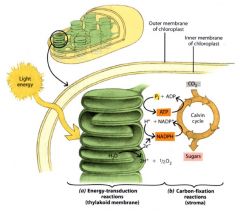
takes place in two stages: the energy-transduction reactions and the carbon-fixation reactions.
|
|
|
THE REACTIONS OF PHOTOSYNTHESIS:
summary of the energy- transduction reaction: |
light energy absorbed by chlorophyll a molecules in the thylakoid membrane is used indirectly to power the synthesis of ATP. Simultaneously, in the interior of the tylakoid, water is split into oxygen gas and hydrogen atoms. The electrons are ultimately accepted by the NADP+ and H+ producing NADPH.
|
|
|
THE REACTIONS OF PHOTOSYNTHESIS:
summary of the carbon-fixation reaction: |
occurs in the stroma of the chloroplast, sugars are synthesized from carbon dioxide and the hydrogen carried by HADPH. This process is powered by the ATP and NADPH produced in the energy-transduction reactions.
|
|
|
THE REACTIONS OF PHOTOSYNTHESIS [Two Photosystems Are Involved in the Light Reactions]:
Over view of photosystem: |
- each includes an assembly of about 250-400 pigment molecules and consists of two closely linked components: the antenna complex and reaction center.
- light energy absorbed by a pigment molecule anywhere in the antenna complex is transferred from one pigment to another by resonance energy transfer until it reaches the reaction center. - when either of the two special chlorophyll a molecules of the reaction center absorb energy, one of its electrons is boosted to a higher energy level and transferred to an electron-acceptor molecule to initiate electron flow. [chlorophyll molecule is therefore oxidized and positively charged] |
|
|
THE REACTIONS OF PHOTOSYNTHESIS [Two Photosystems Are Involved in the Light Reactions]:
antenna complex: |
consists of pigment molecules that gather light energy and "funnel" it to the reaction center
|
|
|
THE REACTIONS OF PHOTOSYNTHESIS [Two Photosystems Are Involved in the Light Reactions]:
antenna pigments: |
pigments which are part of the light-gathering network located in the antenna complex
|
|
|
THE REACTIONS OF PHOTOSYNTHESIS [Two Photosystems Are Involved in the Light Reactions]:
reaction center: |
made up of a complex of proteins and chlorophyll molecules that enable light energy to be converted into chemical energy.
|
|
|
THE REACTIONS OF PHOTOSYNTHESIS [Two Photosystems Are Involved in the Light Reactions]:
Energy transfer during photosynthesis: |

light energy absorbed by a pigment molecule anywhere in the antenna complex passes by resonance energy transfer from one pigment molecule to another until it reaches one of two special chlorophyll a molecules at the reaction center. When a chlorophyll a molecule at the reaction center absorbs the energy, one of its electrons is boosted to a higher energy level and is transferred to an electron-acceptor molecule
|
|
|
THE REACTIONS OF PHOTOSYNTHESIS [Two Photosystems Are Involved in the Light Reactions]:
The Z scheme: over view of the photosystems: |
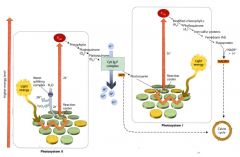
shows pathway of electron transfer from water to NADP+. to raise energy of e-'s derived via photolysis form water to energy level required to reduce NADP+ to NADPH, each e- must be energized twice by photons absorbed in PSI & II. the high energy-electorns flow downhill via electron carrier chains. Protons are pumped across the thylakoid membrane into the thylakoid lumen during the water splitting reaction and during electron transfer through complexes producing proton gradient that is central to ATP formation.
|
|
|
THE REACTIONS OF PHOTOSYNTHESIS [In the Light Reactions, Electorns Flow from Water to Photosystem II to Phtotsystem I to NADP+]:
Photolysis of water: |

the light-dependent oxidative splitting of water.
- contributes to the generation of a proton gradient across the thylakoid membrane [ ATP generation] |
|
|
THE REACTIONS OF PHOTOSYNTHESIS [In the Light Reactions, Electorns Flow from Water to Photosystem II to Phtotsystem I to NADP+]:
Chemiosmotic coupling mechanism of photophosphorylation: |
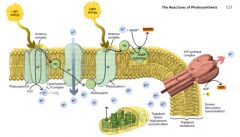
electrons move from water through PS II, the intermediate chain of electron carriers, PS I, and finally to NADP+. Protons are pumped from the stroma into the thylakoid lumen by the flow of electrons through the chain of carriers between PS II and PS I. Creates an electochemical proton gradient, which drives ATP synthesis as the protons flow down this gradient through an ATP synthase complex in the membrane and reenter the stroma.
|
|
|
THE REACTIONS OF PHOTOSYNTHESIS [In the Light Reactions, Electorns Flow from Water to Photosystem II to Phtotsystem I to NADP+]:
Photophosphorylation: |
light provides the energy used to establish the proton gradient, thus chloroplasts and mitochondria generate ATP.
|
|
|
THE REACTIONS OF PHOTOSYNTHESIS [In the Light Reactions, Electorns Flow from Water to Photosystem II to Phtotsystem I to NADP+]:
What must be absorbed to create one oxygen atom? |
two photons must be absorbed by PS II and two by PS I in order to reduce one molecule of NADP+ to NADPH and to produce one atom of oxygen.
|
|
|
THE REACTIONS OF PHOTOSYNTHESIS [In the Light Reactions, Electorns Flow from Water to Photosystem II to Phtotsystem I to NADP+]:
noncylic electron flow: |
in the light, electron flow continuously from water through PS II and I to NADP+, resulting in the oxidation of water to oxygen (O2) and the reduction of NADP+ to NADPH.
|
|
|
THE REACTIONS OF PHOTOSYNTHESIS [Cyclic Photophosphorylation Generates Only ATP]:
Cyclic Electron Flow in PS I: |
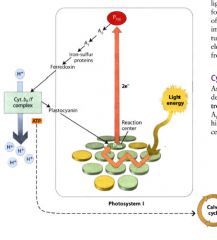
- energized electrons are transferred from P(700) to A(0)... the electrons are shunted to an acceptor in the electron transport chain between both photosystems.
- electrons then pass downhill through that chain back into the reaction center of PS I. ---- driving the transport of protons across the thylakoid membrane and powering the generation of ATP. [no O2, no NADPH, only ATP] |
|
|
THE CARBON-FIXATION REACTIONS:
overview of carbon-fixation reactions: |
the ATP and NADPH generated by the light reactions are used to fix and reduce carbon and to synthesize simple sugars.
|
|
|
THE CARBON-FIXATION REACTIONS:
How does carbon dioxide reach the photosynthetic cells in plants? |
through special openings in the leaves and green stems called the stromata.
|
|
|
THE CARBON-FIXATION REACTIONS:
Where does the calvin cycle occur? |
in the stroma of the chloroplast
|
|
|
THE CARBON-FIXATION REACTIONS [in the Calvin Cycle, carbon dioxide Is Fixed via a Three-Carbon Pathway]:
What is the starting (ending) compound in the calvin cycle? |
a 5-carbon sugar with 2 phosphate groups called RuBP.
|
|
|
THE CARBON-FIXATION REACTIONS [in the Calvin Cycle, carbon dioxide Is Fixed via a Three-Carbon Pathway]:
What is another name for the calvin cycle? |
C3 pathway
|
|
|
THE CARBON-FIXATION REACTIONS [in the Calvin Cycle, carbon dioxide Is Fixed via a Three-Carbon Pathway]:
What is RuBP carboxylase/oxygenase: |
- often called rubisco for short
- enzyme that catalyzes the crucial initial reaction of the cavin cycle. |
|
|
THE CARBON-FIXATION REACTIONS [in the Calvin Cycle, carbon dioxide Is Fixed via a Three-Carbon Pathway]:
What are the 3 stages of the calvin cycle: |
1: Fixation:
- begins when carbon dioxide enters the cycle and is enzymatically combined with RuBP. - results: 6-carbon compound (unstable enzyme-bound intermediate) which is hydrolyzed to generate two PGA (PGA contains 3-carbon atoms) 2. Reduction: PGA is reduced to PGAL [occurs in 2 steps] - PGA kinase catalyzes the transfer of phosphate from ATP to PGA - NADPH donates electrons into a reduction catalyzed PGAL denhydrogenase producing PGAL. 3. Regeneration of acceptor: 5 of the 6 molecules of PGAL are used to generate 3 molecules of RuBP. |
|
|
THE CARBON-FIXATION REACTIONS [in the Calvin Cycle, carbon dioxide Is Fixed via a Three-Carbon Pathway]:
What is the overall equation of the calvin cycle: |

|
|
|
THE CARBON-FIXATION REACTIONS [in the Calvin Cycle, carbon dioxide Is Fixed via a Three-Carbon Pathway]:
What is the immediate product of the cavlin cycle? |
Clyceraldehyde 3-Phosphate (PGAL)
[the primary molecule transported form the chlroplast to the cytosol of the cell] |
|
|
THE CARBON-FIXATION REACTIONS [in the Calvin Cycle, carbon dioxide Is Fixed via a Three-Carbon Pathway]:
Summary of the Calvin cycle: |
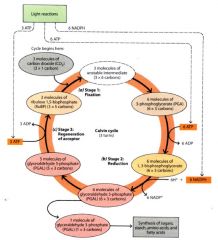
at each full "turn of the cycle, one molecule of carbon dioxide enters the cycle. Three turns are the number required to make one molecule of PGAL, the equivalent of one molecule of a 3-carbon sugar. The energy that drives the Calvin cycle is provided in the form of ATP and NADPH, produced by the light reaction of photosynthesis.
|
|
|
THE CARBON-FIXATION REACTIONS [Most fixed carbon is converted to sucrose or starch]:
What happens to PGAL produced by the calvin cycle? |
- much is exported to the cytosol which is converted to sucrose.
- PGAL which remains in chloroplast is converted to strach, which is stored temp. during the light period as starch grains in the stroma. at night sucrose is then produced from the starch. |

